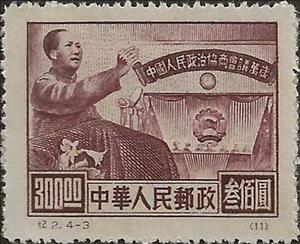Stamp: Mao Tse-tung (Original) (China, People's Republic 1950)
Mao Tse-tung (Original) (China, People's Republic 1950)
01 July (China, People's Republic ) within release 1 Anniv. Establishment People's Gov. on 1 October, 1949 goes into circulation Stamp Mao Tse-tung (Original) face value 1,000 Chinese dollar
| Stamp Mao Tse-tung (Original) in catalogues | |
|---|---|
| Michel: | Mi: CN 32I |
| Stamp Number: | Sn: CN 32 |
| Yvert et Tellier: | Yt: CN 850 |
| Stanley Gibbons: | Sg: CN 1433 |
Stamp is vertical format.
Reprints are much more common than originals. They were prepared and put on sale by the Philatelic Agency in order to supply stocks of exhausted issues for collectors and were not valid for postal use.Also in the issue 1 Anniv. Establishment People's Gov. on 1 October, 1949:
- Stamp - Mao Tse-tung (Original) face value 800;
- Stamp - Mao Tse-tung (Original) face value 1,000;
- Stamp - Mao Tse-tung (Original) face value 2,000;
- Stamp - Mao Tse-tung (Original) face value 3,000;
Stamp Mao Tse-tung (Original) it reflects the thematic directions:
A building or edifice is a structure with a roof and walls standing more or less permanently in one place, such as a house or factory. Buildings come in a variety of sizes, shapes and functions, and have been adapted throughout history for a wide number of factors, from building materials available, to weather conditions, to land prices, ground conditions, specific uses and aesthetic reasons. Buildings serve several needs of society – primarily as shelter from weather, security, living space, privacy, to store belongings, and to comfortably live and work. A building as a shelter represents a physical division of the human habitat (a place of comfort and safety) and the outside (a place that at times may be harsh and harmful).
Famous People refers to the fame and public attention accorded by the mass media to individuals or groups or, occasionally, animals, but is usually applied to the persons or groups of people (celebrity couples, families, etc.) themselves who receive such a status of fame and attention. Celebrity status is often associated with wealth (commonly referred to as fame and fortune), while fame often provides opportunities to make money.
A flag is a piece of fabric (most often rectangular or quadrilateral) with a distinctive design that is used as a symbol, as a signaling device, or as decoration. The term flag is also used to refer to the graphic design employed, and flags have since evolved into a general tool for rudimentary signalling and identification, especially in environments where communication is similarly challenging (such as the maritime environment where semaphore is used). National flags are patriotic symbols with varied wide-ranging interpretations, often including strong military associations due to their original and ongoing military uses. Flags are also used in messaging, advertising, or for other decorative purposes. The study of flags is known as vexillology, from the Latin word vexillum, meaning flag or banner.
A head of state (or chief of state) is the public persona that officially represents the national unity and legitimacy of a sovereign state. In some countries, the head of state is a ceremonial figurehead with limited or no executive power, while in others, the head of state is also the head of government. In countries with parliamentary governments, the head of state is typically a ceremonial figurehead that does not actually guide day-to-day government activities and may not be empowered to exercise any kind of secular political authority (e.g., Queen Elizabeth II as Head of the Commonwealth). In countries where the head of state is also the head of government, the president serves as both a public figurehead and the actual highest ranking political leader who oversees the executive branch (e.g., the President of the United States).
A man is an adult male human. Prior to adulthood, a male human is referred to as a boy (a male child or adolescent).





